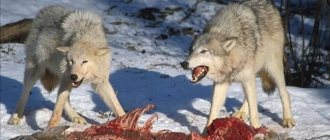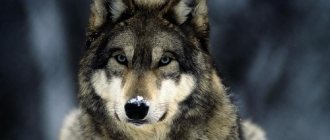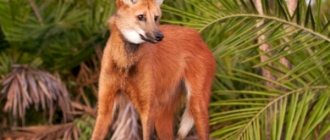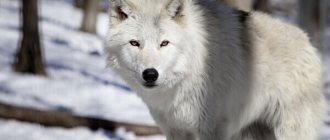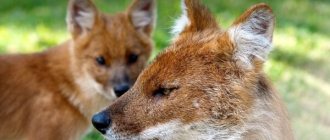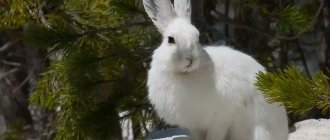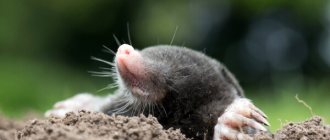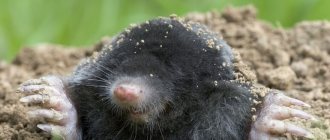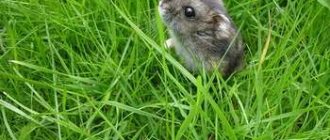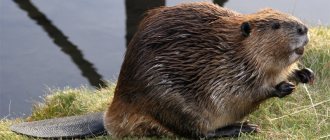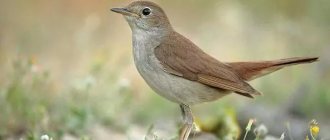- October 12, 2018
- Origin
- Olga Ermolaeva
Everyone knows that people who lived in the pre-Petrine era used names given to them by their neighbors and relatives. Baptismal names, which appeared much later, replaced dynastic names. But for a long time, people used nicknames. Sometimes, when considering the composition of family names, it is not clear where this or that surname comes from. It's all about nicknames.
Howling at the moon
According to the first version, the origin of the Volkov surname is rooted in the simultaneous fear and subordination of humans to wild animals. Such a predator as the wolf, of course, has been familiar to man since ancient times. The name of this animal comes from the verb “to drag away” or “to drag.” Also, the word “wolf” combines two words from the ancient Nakh language. The first “vo” is translated as “howl.” The second, "lakh", means "up". Translated literally, we get “howling up,” that is, howling at the moon.
Some sources say that the surname Volkov means “living next to the wolves,” living where they “howl up” nearby. Very often in historical references there is information about people who lived next to a forest inhabited by wolves. They were first given a nickname, and then the surname Volkov.
Appearance of a coyote
Coyotes are dangerous animals to humans.
The body size of a coyote varies between 76-96 centimeters, which does not take into account the tail, which reaches a length of 30-40 centimeters.
These predators weigh from 7 to 20 kilograms. The southern inhabitants are smaller than their northern counterparts. The largest coyote caught in the north of the continent was 1.75 meters long and its body weight was 33 kilograms. The same parameters are observed in gray wolves.
Brave wolf
The second version, which tells where the surname Volkov came from, is tied to the qualities and character traits of this predator. It is no coincidence that very tough, furious, brave, and sometimes greedy people were called wolves. It was also believed that wolves are some kind of intermediaries between ordinary people and magic, magic. The Slavs unconditionally believed that wolves had magical powers and could protect people from otherworldly forces. The name of this predator sometimes even acted as a talisman.
Judging by these data, the origin of the Volkov surname may be different. Firstly, people with a “wolf” character could receive a surname. Secondly, it could be worn by those who were somehow connected with magic and witchcraft. In ancient times, such people were feared and obeyed at the same time. Volkov could become a person who simply had a strong character and could prove himself in action.
Breeding offspring
During the mating season, males fight fiercely for female wolves. These animals form a pair for life. The next stage of the mating season is the creation of housing.
To breed, wolves set up dens. For this purpose, mountain crevices and burrows of other animals are used; sometimes the wolf digs out the dwelling on its own. The female is constantly present here during the period of raising offspring. As a rule, in one season, wolves give birth to one offspring in the amount of 3 to 13 wolf cubs. Wolves prefer to hunt away from their lair. After the wolf cubs grow up, the family leaves their home and leads a nomadic lifestyle, setting up resting places in different shelters.
Rod of Wolves
From ancient times, let's move to the Russian Empire. It is believed that the Volkovs appeared in our country at the beginning of the 16th century. A Lithuanian from a noble family, Grigory Volk, came to Russia, where he settled. Later, a huge number of noble families with a similar surname will be recorded. These will be governors and clerks, ambassadors and stewards. In 1618, the relatives of Gregory Volk were awarded a large amount of land in the Yaroslavl region. From the armorial records it can be judged that this is one of the oldest and first branches of the Volkovs. Perhaps the tough, strong and wayward nobles of that time accurately confirm the meaning of the Volkov surname described above. They were powerful and ruled six provinces, constantly trying to subjugate the neighboring ones. Greedy, insatiable wolves.
It’s strange, but the Volkov family’s coat of arms did not depict a dangerous predator. There were images of a rose, a helmet, a crown, ostrich feathers, but not a wolf's grin. Surely the Volkovs were simply afraid to think about the ancestor of their surname.
Now let's move on to little-known and unreliable versions that also exist.
Hunting
Wolves forage for food mainly at night. They can chase prey for a long time until it becomes exhausted. The wolf is well developed mentally. This is expressed in hunting methods and methods of protection. Wolves approach their prey unnoticed. When attacking game, each member of the pack performs its own function.
They use various cunning tactics to do this. For example, they drive deer to a cliff, from which the animals are afraid to jump and fall into the clutches of a predator. They try to lure moose to snowy places or to bodies of water covered with ice. Here the victim falls through and cannot escape. A hungry wolf can eat about 12 kg of food at one time. He buries the remains of his prey and returns for it in times of famine.
Wolves gradually teach their cubs to forage for food. Initially, the wolf cubs watch their elders and learn from them all the subtleties and tactics of hunting. They first take part in this activity at the age of six months. Adhering to strict discipline, kids learn skills from their elders.
Son of the wolf
In some encyclopedias there is a description of patronymic Jewish surnames. These are surnames that are formed from male names. As a rule, Jewish names were given according to dynasty, passed down from generation to generation. Some communities may have had children with the same names. For several centuries, every Jewish family had a name that appeared with a certain frequency.
It is believed that the origin of the Volkov surname originates precisely in such “dynastic” names. This is explained simply. Initially there was a male name, Volke, which sometimes sounded like Wolf. If translated from German, then everyone knows that it means wolf. It turns out that Volkov is Wolf’s son. Also in Jewish traditions, this name is associated with the son of Jacob, who was nicknamed the wolf for his bravery. Many centuries ago, this name was very common and popular among Ashkenazi Jews. It was also called kinnuy, that is, household.
Key dietary features
The wolf's diet mainly consists of mammals. Their appearance depends on the habitat of the predator. These are mainly ungulates. Also, the wolf will not refuse small mammals: badger, ferrets, marmots. Often hunts foxes and hares. Among small mammals, the predator prefers mice, hamsters, voles, and gophers.
Often, a wolf ruins a household by eating chickens, geese, calves, and goats. However, this happens quite rarely. If the predator fails to get food, it feeds on frogs, non-venomous snakes and reptiles. If there is a shortage of food, it can turn to carrion. In search of her, the wolf bypasses slaughterhouses, lard dumps, or specially laid out bait.
Thus, the wolf eats both wild and domestic animals. This is a rather brave animal that can start hunting prey that is several times larger than itself. For example, a cow, a horse or an elk. A wolf eats about 2 kg per day. meat. However, if a predator has been in search of food for a long time, then it is able to consume 10-15 kg at once. meat. The wolf hides the uneaten remains of the animal in a cache. When he gets hungry, he simply returns to his hiding place and eats the leftovers.
Lone wolf
According to another version, the origin of the Volkov surname may be connected with the way unloved and unfriendly people were called. A man who was wary of other people, did not like those around him, hid some secret within himself and tried to live as a hermit, and bore the name “wolf.” Years later, and then centuries, the name Volkov began to appear in documents.
What plant foods do carnivores eat?
Wolves are considered omnivores because in addition to meat they also eat plant foods:
- nuts;
- rowan;
- blueberries;
- blueberries;
- lingonberries;
- apples;
- pears;
- cereals;
- reed shoots;
- lily of the valley berries.
This is not a complete list of plant foods that a wolf would not mind eating. In summer, the predator visits melon fields in search of sweet melons and watermelons.
Names and surnames Volkov
When a person is born, he also has a name. But long before this moment, the baby’s parents are going through a huge number of options. In their opinion, the name should not only hide the correct meaning and some secret, but also harmoniously combine with the surname. What name is better to choose for the surname Volkov?
Experts say that there are several rules that will help you choose the right name for your child, so that it not only goes well with the surname, but also has the right influence on fate.
- Firstly, if the surname is short, for example, Volkov, then you can give the child a long, sonorous name.
- Secondly, it is very important to adhere to the harmony of sound. If the surname begins with a consonant, then it is better to choose a name that ends with a vowel.
- Thirdly, it is not recommended to allow a large accumulation of consonant sounds. They should not be at the junction of the end of the first name and the initial letter of the last name. Otherwise, this combination will be difficult to pronounce.
When choosing a name for a child, remember that the surname plays a huge role, it is a carrier of information and contains the secret of the ancestors.
Description of the animal
Scientists consider the historical homeland of the first wolves, which appeared about 2 million years ago, to be North America. In the process of separation of genealogical lines and their evolutionary development, changes occurred in the structure of the body of predators and their appearance, allowing them to move long distances and successfully hunt even quite large prey.
Polar
Adaptation to the environment in wolves is manifested in the color and low thermal conductivity of the coat, the structure of the lower part of the paws, the location of scent glands on the lower part of the feet, and the shape and strength of the teeth.
Wolves are social animals. They form packs with a clear division of powers. A group can contain from several to several dozen individuals of different ages and sexes.
Canadian
Predators have a very acute sense of smell, with which they receive most of the information. Wolves have a developed communication system: they are able to inform pack members about danger, the location and direction of movement of prey. Sometimes wolves howl as a whole pack. It is believed that in this way they express belonging to a group and communicate with other groups or lonely relatives.
The normal body temperature of a wolf is 37-39 degrees. Thermoregulation at low ambient temperatures is ensured by thick and long fur. The wolf's coat consists of longer, stiffer guard hairs and water-repellent fluff.
What does a predator look like?
Mexican
The appearance of wolves has several common features:
- the body is smooth, elongated, the back part is usually slightly lowered down;
- the head is large, round, with a wide forehead, pointed ears and a massive muzzle;
- the paws are long, the two middle toes on the foot are somewhat extended forward;
- the tail is wide along its entire length and is always lowered;
- Wolf eyes usually have a yellow or orange iris, in some species it remains blue, like two-week-old wolf cubs.
The shade of the fur depends on the living conditions. Sometimes cases of albinos appear in species with naturally dark coat color.
How many years do they live
The maximum lifespan of a wolf in natural conditions is 14-15 years. More than half of the puppies born die in the first year of life. Adults die during hunting and from disease. Wolves that have lived to 2-3 years and reached sexual maturity are called seasoned. Until the age of 10-12 years, the most active period of the life of predators lasts, after which the animal begins to show signs of old age.
Indian
Weight and dimensions
Wolves living in different regions differ significantly from each other not only in appearance, but also in size. Thus, predators living in colder climates are larger and more massive than those common in subtropical and tropical zones.
| View | Weight , kg | Height (height at withers), cm |
| polar Wolf | 85 | 90 |
| Canadian wolf | 65 | 80 |
| Mexican wolf | 40 | 70 |
| Indian wolf | 30 | 70 |
| Arabian wolf | 20 | 60 |
Role in nature
Like all predators, the wolf is dangerous to humans. Hungry animals can cause significant harm to livestock production. In addition, there are cases when animals attacked people. But they play an important role in the ecosystem.
Firstly, wolves are forest orderlies who exterminate weak and sick animals, stopping the spread of infection. Secondly, predators restore the natural balance. So, in an American national park at one time a lot of deer appeared and quickly destroyed the vegetation. After the wolf pack was released into the park, the deer population declined. This contributed to the restoration of the flora, the appearance of animals that had not been in the reserve for many years (beavers, ducks, hares, hawks) and the revival of the ecological system as a whole.
